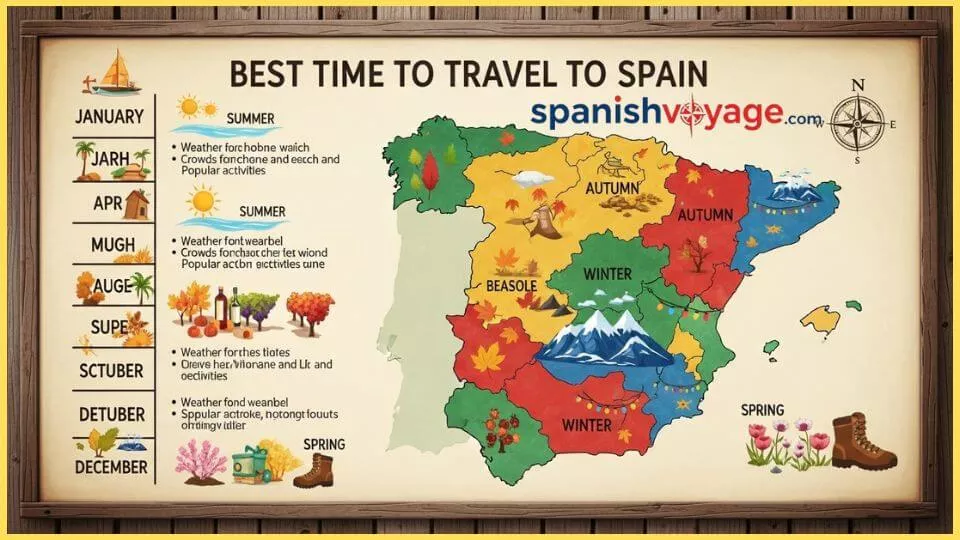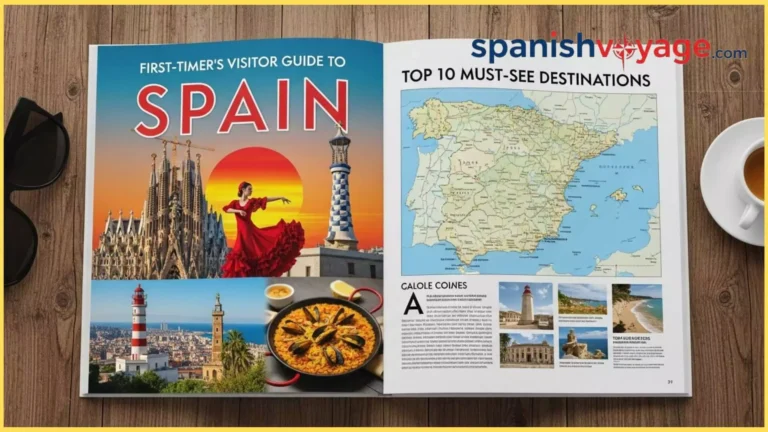When Is the Best Time to Travel to Spain
Spain’s basically open for business year-round, and honestly, that’s what makes it so great. Whether you’re into beach vibes, city exploring, or just eating your way through tapas bars, there’s a perfect window for whatever you’re after. The sweet spot for most people? Spring and fall, when the weather’s just right and you won’t be fighting crowds everywhere you go.
Spain’s Climate: All Over the Map
Spain’s not just one climate—it’s like five different countries mashed together. You’ve got the Mediterranean coast with those classic sunny beach days, the central plateau where Madrid sits (hello, freezing winters and scorching summers), the green and rainy northern hills that look nothing like the Spain in postcards, and the southern desert areas where it gets crazy hot. Then there are the Canary Islands doing their own thing with basically perfect weather all year.
This means timing really depends on where you’re headed. The coast’s totally different from inland cities, and the north plays by completely different rules than the south.
Best Time to Visit Spain by Season
Spring (March to May)
Spring’s honestly one of the best times to go. The weather’s mild, flowers are blooming everywhere, and you’re not sweating through your shirt by 10 AM. Southern Spain warms up early, so places like Seville and Granada are already gorgeous by March. Plus, you get all the Easter festivals—Semana Santa in Seville is unreal if you’re into that kind of thing.
The downside? Easter week can get packed and pricey, but outside of that, you’re golden. It’s also perfect for wine tours in La Rioja and wandering around cities like Barcelona without melting.
Summer (June to August)
Summer’s beach season, plain and simple. The coast and islands are at their best—think Mallorca, Ibiza, Costa del Sol. But here’s the catch: inland cities like Madrid and Seville turn into actual ovens (we’re talking 35-40°C). Locals literally leave if they can.
This is peak season, so expect crowds and higher prices. But if you stick to the coast or head north to San Sebastián and the Basque Country, the weather’s way more manageable. And there are tons of festivals—San Fermín (Running of the Bulls), La Tomatina, music fests everywhere.
Autumn (September to November)
Fall might be even better than spring, honestly. September and October especially—still warm enough for the beach, but the crazy crowds are gone. It’s harvest season, so wine regions like La Rioja are buzzing with festivals and tastings.
Prices drop compared to summer, and you can actually get into popular spots without booking months ahead. October’s particularly awesome for mild weather and fall colors. By November it’s getting quieter and cheaper, though some coastal places start closing up.
Winter (December to February)
Winter’s hit or miss depending on where you go. Southern Spain and the Canary Islands? Still pretty nice—mild temps, sunshine, and barely any tourists. Great for budget travelers who don’t mind skipping the beach.
But if you’re into skiing, the Pyrenees and Sierra Nevada are open from December to March/April. Sierra Nevada’s actually the southernmost ski resort in Europe, which is kinda wild.
The north gets cold and rainy, so not ideal unless you love that vibe. Christmas markets are cute, though, and New Year’s can be fun if you don’t mind the holiday rush.
Best Time to Visit Spain by Activity
Beach vacations: June through early September is your window. Water’s warm, beach clubs are open, it’s the full experience.
Sightseeing and cities: March to June or September to November. You can walk around without dying from heat, and museums aren’t insanely packed.
Wine tasting and foodie stuff: September and October during harvest, or April to June in spring. La Rioja, Ribera del Duero—all the wine regions are at their best.
Skiing: December to March, sometimes into April depending on snow. Sierra Nevada and the Pyrenees both have solid seasons.
Festivals: Honestly year-round, but spring and summer have the big ones. Semana Santa in spring, San Fermín and La Tomatina in summer, local fiestas everywhere.
Regional Breakdown
Northern Spain (Basque Country, Galicia): Summer’s best here—June to August—when it’s green and lush but not too hot. The rest of the year can be rainy and cool.
Central Spain (Madrid, Toledo): Spring and fall for sure. Summer’s brutal, winter’s freezing—Madrid averages like 8°C in winter and 32°C in July.
Southern Spain (Andalusia): Spring and winter are ideal. Summer’s way too hot unless you’re okay with staying indoors during midday.
The Islands (Canary and Balearic): The Canaries are good year-round thanks to that “eternal spring” climate. The Balearics (Mallorca, Ibiza) are best May to September.
Cheapest and Least Crowded Time to Visit Spain
If you’re on a budget, go between November and February (but avoid Christmas/New Year). Flights and hotels are way cheaper, and you’ll have major attractions almost to yourself. January and February are the absolute cheapest.
March and November are solid shoulder months too—still affordable, but with better weather than deep winter. You might need a jacket, but it’s nothing crazy.
Events and Festivals Calendar
Spain doesn’t mess around with festivals. Here are some big ones to plan around:
La Tamborrada (January 20): Drum festival in San Sebastián.
Carnival (February): Party season, especially big in Cádiz and Tenerife.
Semana Santa (Easter week, varies): Huge processions, especially in Seville and Málaga.
Feria de Abril (April/May): Seville’s spring fair with flamenco, horses, and sherry.
San Fermín (July 6-14): Running of the Bulls in Pamplona.
La Tomatina (last Wednesday of August): Tomato fight in Buñol.
Primavera Sound (June): Massive music festival in Barcelona.
Grape harvest festivals (September-October): All over wine country.
These events can jack up prices and fill hotels fast, so book early if you’re planning around them.
Tips for Planning Your Trip
Book ahead for peak times: Summer and major festivals mean you need to reserve flights and hotels way in advance. Shoulder seasons give you more flexibility.
Pack smart: Layers in spring and fall, sunscreen and light clothes in summer, a jacket for winter evenings. Northern Spain needs rain gear pretty much always.
Use local transport: Trains and buses are solid in Spain, way cheaper than renting a car for cities. The metro systems in Madrid and Barcelona are super easy.
Avoid tourist traps: Eating near major monuments = overpriced and mediocre. Walk a few blocks away and you’ll find better food for half the price.
Carry some cash: Most places take cards, but smaller spots and rural areas might be cash-only. Keep €20-30 on you.
Start Planning Your Spanish Adventure Today
Bottom line: May and September are your best all-around bets for Spain—great weather, manageable crowds, and reasonable prices. But honestly, Spain works year-round if you pick the right region for the season. Beach bum? Go in summer. Budget traveler? Winter’s your friend. Culture and food? Spring or fall all the way. Figure out what matters most to you, check the festival calendar, and you’re set.







